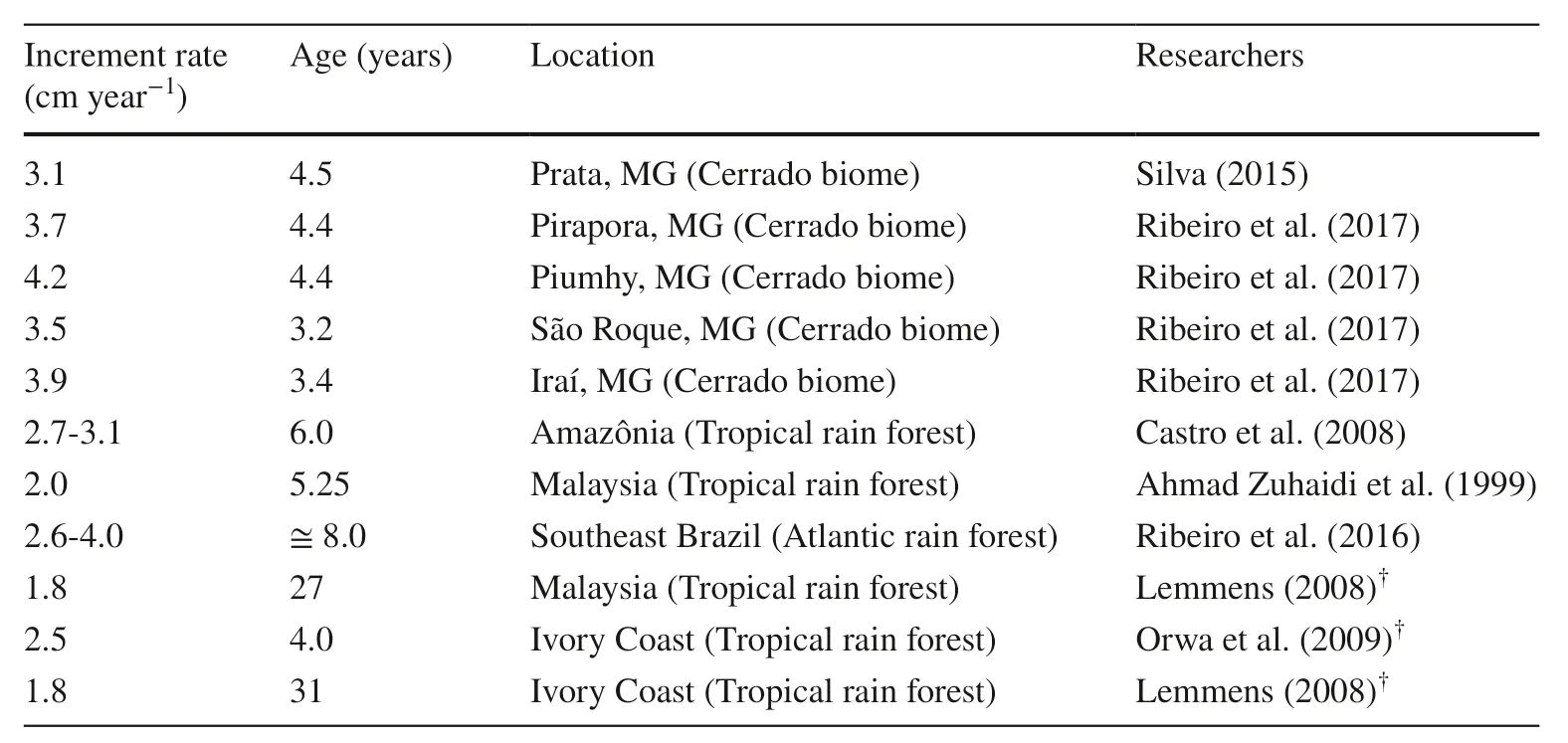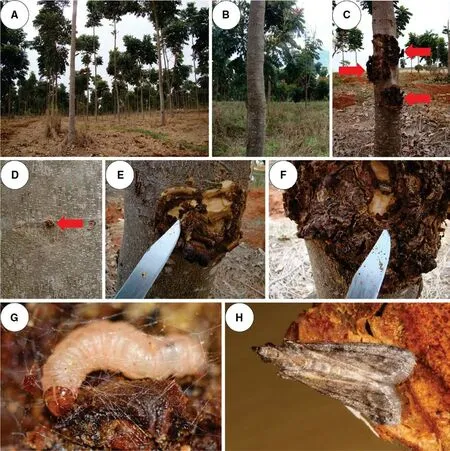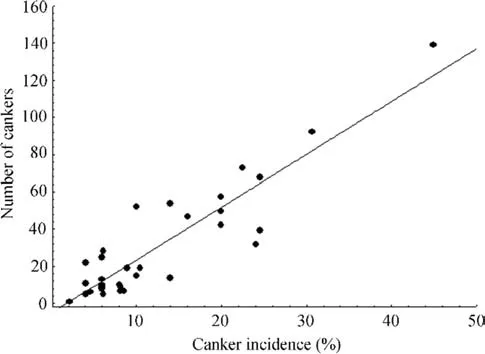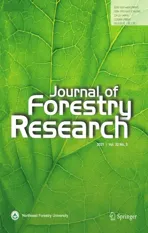Unveiling an important interaction in forestry: Ectomyelois muriscis and Khaya grandifoliola cankers and tree growth
2021-04-30siasCoelhoAndrTerraNascimentoJeanCarlosSantosVinciusFlabesSilva
Lísias Coelho · André R. Terra Nascimento ·Jean Carlos Santos · Vinícius Flabes Silva
Abstract African mahogany, Khaya grandifoliola C. DC.,is the most planted mahogany species in Brazil, and became the choice species when plantations of Brazilian mahogany,Swietenia macrophyla King became unsustainable due to their susceptibility to the shoot borer Hypsipyla grandella Zeller. This study evaluated plantation growth and the occurrence of cankers associated with Ectomyelois muriscis Dyar larvae. Surveys recorded plantation volume, survival, and canker incidence of a plantation established in 2010 at 6 m × 5.5 m spacing. Larvae were collected and reared on canker bark fragments until f inal adult stage. Cankers were frequently associated with Ectomyelois muriscis larvae. The average incidence of the moth (2.9%) was not a signif icant concern, however, an extreme incidence of 45% would indicate that management strategies should be developed. This is the f irst report of Ectomyelois muriscis attacking the bark of Khaya grandifoliola in the Cerrado biome.
Keywords African mahogany · Stem cankers · Potential pest · Stand growth
Introduction
Fast-growing plantations are a renewable source of valuable raw materials and, for this reason, the area of plantations are continuously expanding in Brazil (Juvenal and Mattos 2002),providing fuel wood, pulp for paper, essential oils, logs for sawmills and for lamination materials.
According to the Indústria Brasileira de Árvores (IBÁ 2018), the area of plantations for industry was 7.84 million hectares in 2017. Only 10% of this area is planted with species suitable for veneer, laminated wood panels and solid timber.
The current supply of mahogany comes from the harvesting of two species, Brazilian mahogany (Swietenia macrophyllaKing) and American mahogany (S. mahagoni(L.)Jacq.) from the Amazon rainforest, from plantations in other regions of Brazil and from around the world. Harvesting in Brazil still is the main source of mahogany (S. macrophylla),which is listed as vulnerable (Martinelli and Moraes 2013;IUCN 2020). Therefore, an alternative for the sustainable production of timber for lamination and solid products is by planting species of African mahogany (Khayaspp.) of the family Meliaceae (Lamprecht 1990).
Besides the risk of extinction of Brazilian mahogany, the shoot borer (Hypsipyla grandellaZeller) makes monocultures unsustainable, and is the limiting factor for commercial plantations ofS. macrophyllaandS. mahagoniin the Americas (Lunz et al. 2009). According to these researchers, no single technique is capable of controlling this insect and requires the adoption of an integrated pest management(IPM) approach.
A related species, the cedar tip moth (Hypsipyla robustaMoore) appears to be a limiting factor for plantations ofKhayaspp. outside of the Americas (Eungwijarnpanya 2001; Ghee 2001; Ngoro 2001). According to Abraham et al.( 2014), this pest caused diff erent degrees of damage in four forest species, includingK. anthotheca(Welw.) C.DC., East African mahogany, andK. ivorensisA. Chev., African or Lagos mahogany. The cedar tip moth has not been reported in Brazil.
The best known African mahogany species areKhaya ivorensis, K. senegalensis(Desr.) A. Juss, K. grandifoliolaC. DC., andK. anthotheca, of whichK. ivorensisandK.senegalensisaccount for the most extensive plantations(Lamprecht 1990). In Brazil,K. grandifoliolahas in the past been mistakenly planted asK. ivorensis. These two species could satisfy the demand for mahogany, if the plantations are properly managed, and proven to be economically viable and sustainable.
Khaya ivorensisandK. grandifoliolaare fast growing,have natural pruning properties and straight trunks (Soares 2014), and could replaceS. macrophylla(Brazilian mahogany) as there are little diff erences in wood characteristics and quality (Lamprecht 1990). Natural distribution ofK. ivorensisspreads from the Ivory Coast to Cameroon and Angola,while the range ofK. grandifoliolais from the Republic of Guinea on Africa’s west coast to Sudan and Uganda in the east (Bouka-Dipelet et al. 2019).
Plantation spacing in Brazil is quite variable, from dense plantings of 3 m × 3 m to wider spacings such as 5 m × 5 m,6 m × 5 m or 6 m × 6 m (Scolforo and Ferraz Filho 2014).Due to its plasticity, its ability to adapt to changes in its environment, Gomes ( 2010) notes that, with adequate cultural treatments during early years,K. grandifoliolahas favorable attributes for cultivation and good prospects of prof itability. However, more research is needed on aspects such as silviculture and management, wood technology, and forest pathology and entomology (Soares 2014). Although bark cankers have been reported in Brazil (Souza et al. 2015),Silva ( 2015) was the f irst report associating these to a Lepidoptera species.
This study reports the occurrence of a species of snout moth,Ectomyelois muriscis(Lepidoptera: Pyralidae), associated with bark cankers and stand growth in plantations ofKhaya grandifoliolain the region of Triângulo Mineiro,Minas Gerais, Brazil.
Materials and methods
The research was carried out in a 300-ha plantation at Farm Africa in the county of Prata, Minas Gerais (19°09ʹS,48°59ʹW), March 2015. The plantation was established September 2010 at a spacing of 6 × 5.5 m (303 plants per hectare) and the stand age was 4.5 years.
Plantation and canker evaluations were done in 34 random plots consisting of 5 rows with 10 trees for a total area of 1650 m 2 . Diameter at breast height (DBH) was measured and trees with stem cankers were counted in each plot, the average infestation estimated, and the number of cankers, up to 2 m above the soil, recorded to estimate severity (cankers m −2 of trunk surface).
Data were tabulated in Excel spreadsheet (Microsoft Offi ce©). Tree diameter distribution was adjusted to a normal distribution using the software STATISTICA version 8.0 (StatSoft 2007). Basal area (sum of trunk sectional areas per hectare) was estimated. The relation between incidence (number of trees with canker) and severity (number of cankers per tree), was analyzed using linear regression according to the assumptions for this type of analysis(Zar 1999).
Larvae were collected from the cankers and reared on canker bark fragments until the imagoes or f inal adult stage could be obtained. The bark fragments were placed in plastic pots with damp cotton wool to maintain moisture, the pot lids were replaced with screens to allow air exchange and prevent adults from escaping. Daily inspections were carried out to collect adults which were mounted using entomological pins and sent for identif ication. Adult insects or imagoes were identif ied by Dr. Vitor Osmar Becker, from the Uiraçu Institute, Camacan, Bahia, Brazil. Voucher specimens were deposited in the V. O. Becker Collection.
Results
Average survival in the plantation was 98%. Tree mortality(2%) was associated with breakage, usually because of a bifurcated trunk. The survey had a sampling error of 4.1%(p< 0.10), and may be used for analysis of stand growth and management planning for thinning and harvesting. Average DBH was 14.0 ± 0.2 cm and the basal area 4.7 ± 0.1 m 2 ha −1 . Increment rate, based on average diameter and age was 3.1 cm year −1 , which was reasonable in face of limiting factors of the Cerrado biome (soil acidity, and rainfall volume and distribution), and in comparison with other studies(Table 1).

Table 1 Increment rate and age of Khaya grandifoliola and K. ivorensis stands in diff erent biomes

Fig. 1 Distribution of Khaya grandifoliola by diameter class (bars)and normal distribution (dashed line)
Analysis of the diameter distribution shows that no thinning had been done in the plantation, f itting the normal distribution (Chi Square = 55.62;p< 0.00001), with the greatest number of trees with diameters near the center of the distribution curve, with no skewness (Fig. 1). This distribution is characteristic of trees planted in even-aged stands and usually adjusts well to symmetrical distributions, such as a normal distribution.
Cankers were observed onKhaya grandifoliolatrunks(Fig. 2). Average canker incidence was 12%, reaching a maximum of 45% in one plot. Canker severity, the number of cankers m −2 of trunk, up to 2 m above the ground, showed that half of the aff ected plots had less than four cankers, and only one had 14 cankers m −2 . The number of cankers in the area was directly proportional to canker incidence (r 2 = 0.81;p< 0.05), although no such relationship was observed with canker severity (Fig. 3).
Larvae ofE. murisciswere found in several stages of development, frequently with 3 to 5 larvae per canker.Although there is a direct relation between incidence and number of cankers, the plot with the greatest incidence(45%) was not the one with the greatest severity (14 cankers m −2 ).
Discussion
The high survival rate (98.0%) after 4.5 years indicates good plantation management. Azevedo ( 2010), studyingKhaya ivorensis(K. grandifoliola), recorded 96.0% survival one year after planting.
Tree form can be conditioned by several factors, among which is planting density. Plantation trees compete for available resources, both from the soil and at the canopy level(Fabião 1987). Thus, according to Imaña Encinas et al.( 2002), diameter, regardless of the tree stratum, is aff ected by planting density. Therefore, whenever competition is present, the relation height/diameter is greater than under lower competition.
The growth rate of this plantation is below expected values for the plantations in the State of Minas Gerais (Scolforo and Ferraz Filho 2014). According to Balloni and Simões( 1980), analyzing the relationship of planting density with other variables in an even-age stand, the lower the density,the greater the diameter; in contrast, average height increases with increasing planting density. However, this may not always the case, and climate factors should be considered in the decision process for planting density. Schneider et al.( 2005) reported signif icant correlation between tree mortality and factors such as age, height, diameter and basal area in a black wattle (Acacia mearnsiiDe Wild) plantation, and that mortality increased in denser plantings due to competition.

Fig. 2 Khaya grandifoliola, bark canker and Ectomyelois muriscis. a Partial view of the plantation; b healthy trunk; c typical cankers (red arrows); d detail of leaf petiole scar and axillary bud (red arrow); e- g Larvae of E. muriscis in several stages of development; h. Adult E.muriscis
The f irst reports of canker inK. ivorensis(possiblyK.grandifoliola) date from 1998 (Müller et al. 2002) in Bahia,and subsequently in the state of Pará (Tremacoldi et al. 2013;Furtado and Benso 2019) and was attributed to the fungusLasiodiplodia theobromae(Pat.) Griff on & Maubi. However, it is considered a weak, secondary pathogen, entering the host plant after infection by other pathogens or through wounds (Ferreira 1989; Alfenas et al. 2004).

Fig. 3 Relation between canker incidence and number of cankers(linear regression with r 2 = 0.81; p < 0.05)
According to Lamprecht ( 1990), wounds of traumatic origin in the trunks of trees can cause exudation of resins or gums. Thus, it is possible that cankers were formed onK. grandifoliolastems after injuries caused by egg laying or by hatched larvae ofE. muriscis. Cankers appear to be associated with leaf petiole scars, usually with a dormant axillary bud (Fig. 2), which would be a possible target forE. muriscis.
Hypsipyla robustacauses damage in tropical African mahogany plantations and forests and is considered as the most economically important pest in the tropics, aff ecting species ofKhaya, Cedrela,SwieteniaandToona(Griffi ths et al. 2004). Ghee ( 2001) suggested that mixed plantings ofK. ivorensiswithS. macrophyllaandS. mahagonireduced attacks byH. robusta.WhileH. robustais a major pest of Meliaceae in Africa and Asia,H. grandellais the major pest of Meliaceae in the Americas. According to Falesi and Baena ( 1999), African mahogany (K. grandifoliola) has not been parasitized byH. grandellain Brazil.
Although species of the genusHypsipylaare the only ones reported attacking shoots, which are tender, primary tissues, there are other Lepidoptera aff ecting the stems ofK.grandifoliola. It is possible that other insects are adapting to this exotic species in Brazil, and may become a pest.
Ectomyelois muriscisis a tropical and subtropical species of snout moth widely distributed in Central and South America (Gomez-Ruiz et al. 2015). This is the f irst record ofE. muriscisinfesting the bark of African mahogany (Khaya grandifoliola), a recently introduced species in Brazil with considerable market potential (Bouka-Dipelet et al. 2019).
An interesting observation is that most infestations were in fruits of diff erent tropical species (Table 2); however,damage toK. grandifoliolaoccurred as bark cankers (Fig. 3).Damage to stems ofJatropha curcasL. were reported in Mexico, which possibly was the f irst record of larvae of this species attacking stems of a native species (Gomez-Ruiz et al. 2015). Damage to mature trees, associated with bark cankers, has not been reported.
Such observations should not prompt any control action since average plantation incidence is 12%. However, a plot with 45% incidence could be of some concern. This concern is important for future monitoring of plantations to determine if canker occurrence is random or clustered, with further dissemination from these foci. No diff erences in topography or surrounding vegetation were found to explain canker concentration and associated insect larvae.
Conclusions
Increment and stand growth were below expectations for the Cerrado biome in Central Brazil. Diameter distribution ofKhaya grandifoliolawas a symmetrical distribution, with thegreatest number of trees around the mean, which is common in unthinned even age plantations. Average canker incidence was 12%, with a maximum of 45%. Cankers were associated withEctomyelois muriscisand might require attention for adequate forest pest management in the future. This is the f irst report ofE. muriscisaff ecting bark ofK. grandifoliola,constituting a potential pest since it might aff ect the production of quality timber of this important species in Brazil.

Table 2 Infested species and organ attacked by Ectomyelois muriscis and country of occurrence
Acknowledgements The authors thank Dr. Vitor Osmar Becker(Instituto Uiraçu - Bahia) for the identif ication of the micro-Lepidoptera; and the Faculdade de Matemática (UFU) for the use of the software STATISTICA.
Publisher’s NoteSpringer Nature remains neutral with regard to jurisdictional claims in published maps and institutional affi liations.
杂志排行
Journal of Forestry Research的其它文章
- Sacred groves of India: repositories of a rich heritage and tools for biodiversity conservation
- Relationship between H 2 O 2 accumulation and NO synthesis during osmotic stress: promoted somatic embryogenesis of Fraxinus mandshurica
- Changes in leaf stomatal traits of diff erent aged temperate forest stands
- Somatic embryogenesis and plant regeneration in Betula platyphalla
- Hydrogen peroxide as a systemic messenger in the photosynthetic induction of mulberry leaves
- Production and quality of eucalyptus mini-cuttings using kaolin-based particle f ilms
